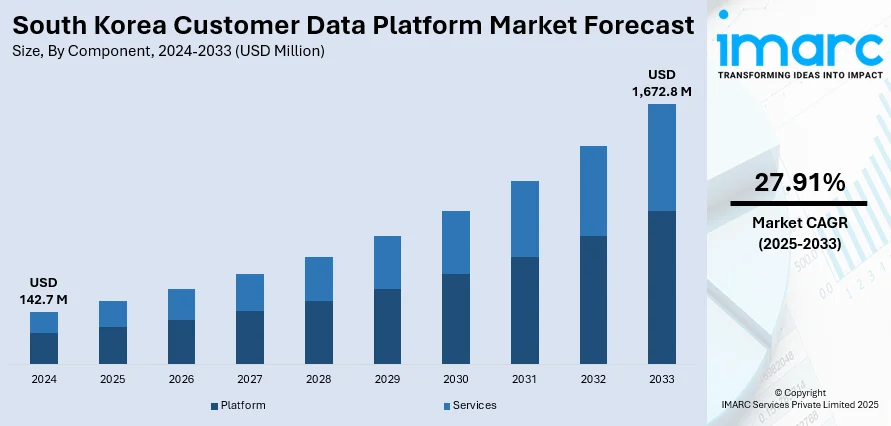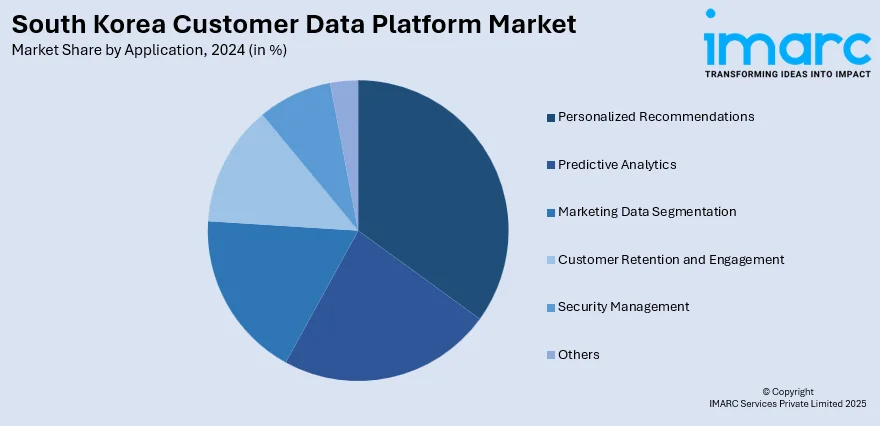
South Korea Customer Data Platform Market Size, Share, Trends and Forecast by Component, Deployment Mode, Organization Size, Application, Vertical, and Region, 2025-2033
South Korea Customer Data Platform Market Overview:
The South Korea customer data platform market size reached USD 142.7 Million in 2024. The market is projected to reach USD 1,672.8 Million by 2033, exhibiting a growth rate (CAGR) of 27.91% during 2025-2033. The market is driven by the rapid growth of digital data, the rise of artificial intelligence (AI)-powered personalization, and a strong national push toward digital transformation. Businesses seek to unify fragmented customer data for real-time insights and smarter engagement across channels. Cloud adoption supports scalable CDP integration, while evolving data privacy laws require platforms that ensure consent, transparency, and trust thus contributing to the South Korea customer data platform market share.
|
Report Attribute
|
Key Statistics
|
|---|---|
|
Base Year
|
2024
|
|
Forecast Years
|
2025-2033
|
|
Historical Years
|
2019-2024
|
| Market Size in 2024 | USD 142.7 Million |
| Market Forecast in 2033 | USD 1,672.8 Million |
| Market Growth Rate 2025-2033 | 27.91% |
South Korea Customer Data Platform Market Trends:
Big Data Growth & AI Integration
In South Korea, companies are collecting large volumes of customer data from websites, apps, call centers, and social platforms—creating rising complexity and fragmented views. CDPs solve this by unifying data into single, actionable profiles. Combined with AI, CDPs enable businesses to detect patterns, predict behavior, and personalize interactions at scale. The growing demand for real-time, dynamic engagement fuels adoption across industries. Supporting this, the government’s K‑Cloud Project, launched in mid-2023 with a USD 100 billion investment, aims to build NPU-enabled AI data centers nationwide. This initiative strengthens the digital backbone needed for high-speed data processing, personalization, and campaign automation. As competition intensifies, AI-powered CDPs become essential for innovation, targeting, and customer loyalty—turning extensive data into meaningful insights and smarter marketing decisions across a fast-evolving digital economy.

To get more information on this market, Request Sample
Digital Transformation & Cloud-Driven Strategies
South Korea’s public and private sectors are accelerating digital modernization with a strong focus on cloud-first strategies thus strengthening the South Korea customer data platform market growth. The Presidential Committee on the Digital Platform Government announced plans to migrate nearly 10,000 government ICT systems to cloud-native architectures by 2030, targeting 30% migration by 2025. This shift reflects a broader trend as organizations adopt cloud infrastructures for agility, scalability, and integration. Within this transformation, Customer Data Platforms (CDPs) have emerged as essential tools—connecting data across websites, cloud apps, and internal systems to deliver a unified customer view. CDPs help break down data silos, enable real-time personalization, and support omnichannel engagement. In sectors like finance, retail, and healthcare—where speed and precision are vital—CDPs align perfectly with digital transformation goals. As both government and businesses aim to enhance long-term operational resilience, CDPs play a foundational role in building intelligent, responsive, and trust-based customer experiences.
Data Privacy Compliance & Trust Building
Another significant South Korea customer data platform market trend is the growing awareness of data rights among consumers and tighter regulations from the South Korean government, companies are under increasing pressure to manage personal data responsibly. Businesses must now ensure that customer information is collected, stored, and used with transparency and clear consent. CDPs are designed to support these requirements by centralizing data governance, allowing organizations to track consent preferences and respond to customer privacy requests more effectively. By embedding privacy into their data practices, companies not only reduce regulatory risk but also build trust with their customers. Trust has become a key differentiator in today’s market, and CDPs help foster that by promoting responsible data use. In a digital environment where loyalty depends on transparency and ethics, CDPs empower organizations to balance personalization with protection fostering more secure and meaningful customer relationships.
South Korea Customer Data Platform Market Segmentation:
IMARC Group provides an analysis of the key trends in each segment of the market, along with forecasts at the country and regional levels for 2025-2033. Our report has categorized the market based on component, deployment mode, organization size, application, and vertical.
Component Insights:
- Platform
- Services
The report has provided a detailed breakup and analysis of the market based on the component. This includes platform and services.
Deployment Mode Insights:
- Cloud-based
- On-premises
A detailed breakup and analysis of the market based on the deployment mode have also been provided in the report. This includes cloud-based and on-premises.
Organization Size Insights:
- Large Enterprises
- Small and Medium-sized Enterprises (SMEs)
The report has provided a detailed breakup and analysis of the market based on the organization size. This includes large enterprises and small and medium-sized enterprises (SMEs).
Application Insights:

- Personalized Recommendations
- Predictive Analytics
- Marketing Data Segmentation
- Customer Retention and Engagement
- Security Management
- Others
A detailed breakup and analysis of the market based on the application have also been provided in the report. This includes personalized recommendations, predictive analytics, marketing data segmentation, customer retention and engagement, security management, and others.
Vertical Insights:
- Retail and E-commerce
- BFSI
- Media and Entertainment
- IT and Telecommunication
- Others
The report has provided a detailed breakup and analysis of the market based on the vertical. This includes retail and e-commerce, BFSI, media and entertainment, IT and telecommunication, and others.
Regional Insights:
- Seoul Capital Area
- Yeongnam (Southeastern Region)
- Honam (Southwestern Region)
- Hoseo (Central Region)
- Others
The report has also provided a comprehensive analysis of all the major regional markets, which include Seoul Capital Area, Yeongnam (Southeastern Region), Honam (Southwestern Region), Hoseo (Central Region), and Others.
Competitive Landscape:
The market research report has also provided a comprehensive analysis of the competitive landscape. Competitive analysis such as market structure, key player positioning, top winning strategies, competitive dashboard, and company evaluation quadrant has been covered in the report. Also, detailed profiles of all major companies have been provided.
South Korea Customer Data Platform Market News:
- In November 2024, KT Corporation partnered with Databricks to drive data and AI innovation in South Korea. The collaboration focuses on building a scalable AI platform using the Databricks Data Intelligence Platform, supporting KT’s sovereign cloud strategy, and enabling end-to-end generative AI development. It also includes plans to establish a Data and AI Center of Excellence and upskill KT employees, further advancing KT’s digital transformation across public and regulated industries.
South Korea Customer Data Platform Market Report Coverage:
| Report Features | Details |
|---|---|
| Base Year of the Analysis | 2024 |
| Historical Period | 2019-2024 |
| Forecast Period | 2025-2033 |
| Units | Million USD |
| Scope of the Report |
Exploration of Historical Trends and Market Outlook, Industry Catalysts and Challenges, Segment-Wise Historical and Future Market Assessment:
|
| Components Covered | Platform, Services |
| Deployment Modes Covered | Cloud-based, On-premises |
| Organization Sizes Covered | Large Enterprises, Small and Medium-sized Enterprises (SMEs) |
| Applications Covered | Personalized Recommendations, Predictive Analytics, Marketing Data Segmentation, Customer Retention and Engagement, Security Management, Others |
| Verticals Covered | Retail and E-commerce, BFSI, Media and Entertainment, IT and Telecommunication, Others |
| Regions Covered | Seoul Capital Area, Yeongnam (Southeastern Region), Honam (Southwestern Region), Hoseo (Central Region), Others |
| Customization Scope | 10% Free Customization |
| Post-Sale Analyst Support | 10-12 Weeks |
| Delivery Format | PDF and Excel through Email (We can also provide the editable version of the report in PPT/Word format on special request) |
Key Questions Answered in This Report:
- How has the South Korea customer data platform market performed so far and how will it perform in the coming years?
- What is the breakup of the South Korea customer data platform market on the basis of component?
- What is the breakup of the South Korea customer data platform market on the basis of deployment mode?
- What is the breakup of the South Korea customer data platform market on the basis of organization size?
- What is the breakup of the South Korea customer data platform market on the basis of application?
- What is the breakup of the South Korea customer data platform market on the basis of vertical?
- What is the breakup of the South Korea customer data platform market on the basis of Region?
- What are the various stages in the value chain of the South Korea customer data platform market?
- What are the key driving factors and challenges in the South Korea customer data platform market?
- What is the structure of the South Korea customer data platform market and who are the key players?
- What is the degree of competition in the South Korea customer data platform market?
Key Benefits for Stakeholders:
- IMARC’s industry report offers a comprehensive quantitative analysis of various market segments, historical and current market trends, market forecasts, and dynamics of the South Korea customer data platform market from 2019-2033.
- The research report provides the latest information on the market drivers, challenges, and opportunities in the South Korea customer data platform market.
- Porter's five forces analysis assist stakeholders in assessing the impact of new entrants, competitive rivalry, supplier power, buyer power, and the threat of substitution. It helps stakeholders to analyze the level of competition within the South Korea customer data platform industry and its attractiveness.
- Competitive landscape allows stakeholders to understand their competitive environment and provides an insight into the current positions of key players in the market.
Need more help?
- Speak to our experienced analysts for insights on the current market scenarios.
- Include additional segments and countries to customize the report as per your requirement.
- Gain an unparalleled competitive advantage in your domain by understanding how to utilize the report and positively impacting your operations and revenue.
- For further assistance, please connect with our analysts.
 Request Customization
Request Customization
 Speak to an Analyst
Speak to an Analyst
 Request Brochure
Request Brochure
 Inquire Before Buying
Inquire Before Buying




.webp)




.webp)












